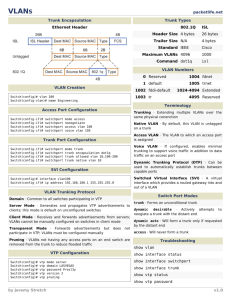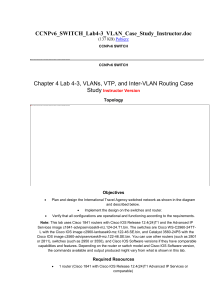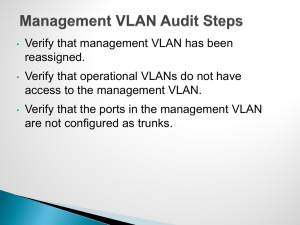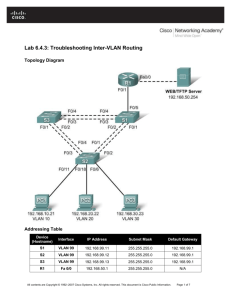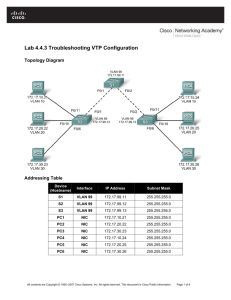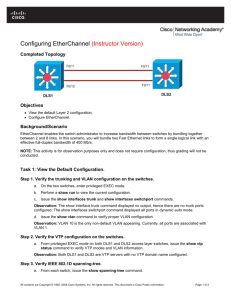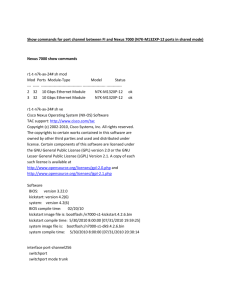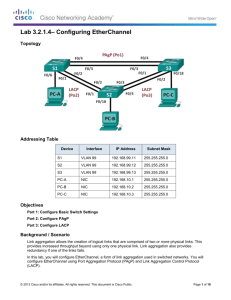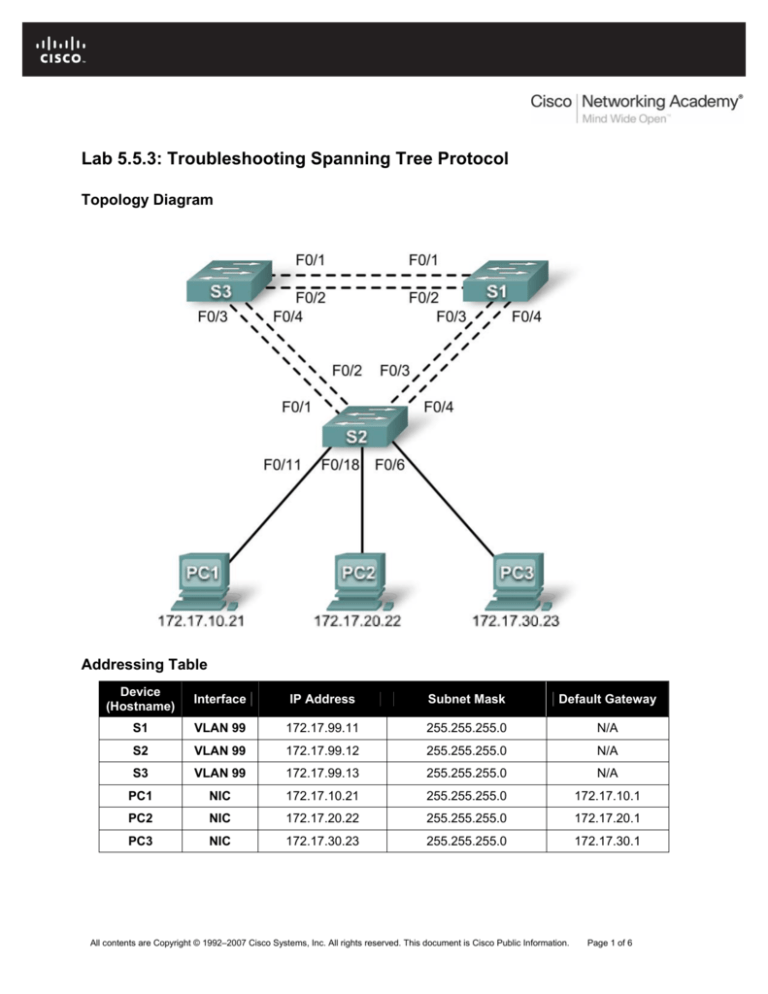
Lab 5.5.3: Troubleshooting Spanning Tree Protocol
Topology Diagram
Addressing Table
Device
(Hostname)
Interface
IP Address
Subnet Mask
Default Gateway
S1
VLAN 99
172.17.99.11
255.255.255.0
N/A
S2
VLAN 99
172.17.99.12
255.255.255.0
N/A
S3
VLAN 99
172.17.99.13
255.255.255.0
N/A
PC1
NIC
172.17.10.21
255.255.255.0
172.17.10.1
PC2
NIC
172.17.20.22
255.255.255.0
172.17.20.1
PC3
NIC
172.17.30.23
255.255.255.0
172.17.30.1
All contents are Copyright © 1992–2007 Cisco Systems, Inc. All rights reserved. This document is Cisco Public Information.
Page 1 of 6
CCNA Exploration
LAN Switching and Wireless: STP
Lab 5.5.3: Troubleshooting Spanning Tree Protocol
Port Assignments – Switch 2
Ports
Assignment
Network
Fa0/1 – 0/4
802.1q Trunks (Native VLAN 99)
172.17.99.0 /24
Fa0/5 – 0/10
VLAN 30 – Guest (Default)
172.17.30.0 /24
Fa0/11 – 0/17
VLAN 10 – Faculty/Staff
172.17.10.0 /24
Fa0/18 – 0/24
VLAN 20 – Students
172.17.20.0 /24
Learning Objectives
Upon completion of this lab, you will be able to:
•
Analyze a congestion problem in a redundant, switched LAN network.
•
Recognize the capabilities for per-VLAN load balancing with PVST.
•
Modify the default STP configuration to optimize available bandwidth.
•
Verify that modifications have had the intended effect.
Scenario
You are responsible for the operation of the redundant switched LAN shown in the topology diagram. You
and your users have been observing increased latency during peak usage times, and your analysis points
to congested trunks. You recognize that of the six trunks configured, only two are forwarding packets in
the default STP configuration currently running. The solution to this problem requires more effective use
of the available trunks. The PVST+ feature of Cisco switches provides the required flexibility to distribute
the inter-switch traffic using all six trunks.
This lab is complete when all wired trunks are carrying traffic, and all three switches are participating in
per-VLAN load balancing for the three user VLANs.
Task 1: Prepare the Network
Step 1: Cable a network that is similar to the one in the topology diagram.
You can use any current switch in your lab as long as it has the required interfaces shown in the topology
diagram. The output shown in this lab is based on Cisco 2960 switches. Other switch models may
produce different output.
Set up console connections to all three switches.
Step 2: Clear any existing configurations on the switches.
Clear NVRAM, delete the vlan.dat file, and reload the switches.
Step 3: Load the switches with the following script:
S1 Configuration
hostname S1
enable secret class
All contents are Copyright © 1992–2007 Cisco Systems, Inc. All rights reserved. This document is Cisco Public Information.
Page 2 of 6
CCNA Exploration
LAN Switching and Wireless: STP
Lab 5.5.3: Troubleshooting Spanning Tree Protocol
no ip domain-lookup
!
vtp mode server
vtp domain Lab5
vtp password cisco
!
vlan 99
name Management
exit
!
vlan 10
name Faculty/Staff
exit
!
vlan 20
name Students
exit
!
vlan 30
name Guest
exit
!
interface FastEthernet0/1
switchport trunk native vlan 99
switchport mode trunk
no shutdown
!
interface FastEthernet0/2
switchport trunk native vlan 99
switchport mode trunk
no shutdown
!
interface FastEthernet0/3
switchport trunk native vlan 99
switchport mode trunk
no shutdown
!
interface FastEthernet0/4
switchport trunk native vlan 99
switchport mode trunk
no shutdown
!
interface range FastEthernet0/5-24
shutdown
!
interface GigabitEthernet0/1
shutdown
!
interface GigabitEthernet0/2
shutdown
!
interface Vlan99
ip address 172.17.99.11 255.255.255.0
no shutdown
!
line con 0
All contents are Copyright © 1992–2007 Cisco Systems, Inc. All rights reserved. This document is Cisco Public Information.
Page 3 of 6
CCNA Exploration
LAN Switching and Wireless: STP
Lab 5.5.3: Troubleshooting Spanning Tree Protocol
logging synchronous
password cisco
login
line vty 0
no login
line vty 1 4
password cisco
login
line vty 5 15
password cisco
login
!
end
S2 Configuration
hostname S2
!
enable secret class
no ip domain-lookup
!
vtp mode client
vtp domain Lab5
vtp password cisco
!
interface FastEthernet0/1
switchport trunk native vlan 99
switchport mode trunk
no shutdown
!
interface FastEthernet0/2
switchport trunk native vlan 99
switchport mode trunk
no shutdown
!
interface FastEthernet0/3
switchport trunk native vlan 99
switchport mode trunk
no shutdown
!
interface FastEthernet0/4
switchport trunk native vlan 99
switchport mode trunk
no shutdown
!
interface range FastEthernet0/5 - 10
switchport access vlan 30
switchport mode access
!
interface range FastEthernet0/11 - 17
switchport access vlan 10
switchport mode access
!
interface range FastEthernet0/18 - 24
switchport access vlan 20
All contents are Copyright © 1992–2007 Cisco Systems, Inc. All rights reserved. This document is Cisco Public Information.
Page 4 of 6
CCNA Exploration
LAN Switching and Wireless: STP
Lab 5.5.3: Troubleshooting Spanning Tree Protocol
switchport mode access
!
interface fa0/6
no shutdown
interface fa0/11
no shutdown
interface fa0/18
no shutdown
!
interface Vlan99
ip address 172.17.99.12 255.255.255.0
no shutdown
!
line con 0
password cisco
logging synchronous
login
line vty 0 4
password cisco
login
line vty 5 15
password cisco
S3 Configuration
hostname S3
!
enable secret class
no ip domain-lookup
!
vtp mode client
vtp domain Lab5
vtp password cisco
!
interface FastEthernet0/1
switchport trunk native vlan 99
switchport mode trunk
no shutdown
!
interface FastEthernet0/2
switchport trunk native vlan 99
switchport mode trunk
no shutdown
!
interface FastEthernet0/3
switchport trunk native vlan 99
switchport mode trunk
no shutdown
!
interface FastEthernet0/4
switchport trunk native vlan 99
switchport mode trunk
no shutdown
!
interface range FastEthernet0/5 - 10
All contents are Copyright © 1992–2007 Cisco Systems, Inc. All rights reserved. This document is Cisco Public Information.
Page 5 of 6
CCNA Exploration
LAN Switching and Wireless: STP
Lab 5.5.3: Troubleshooting Spanning Tree Protocol
switchport access vlan 30
switchport mode access
!
interface range FastEthernet0/11 - 17
switchport access vlan 10
switchport mode access
!
interface range FastEthernet0/18 - 24
switchport access vlan 20
switchport mode access
!
interface Vlan99
ip address 172.17.99.13 255.255.255.0
no shutdown
!
line con 0
password cisco
login
line vty 0 4
password cisco
login
line vty 5 15
password cisco
login
end
Task 2: Configure Host PCs
Configure the Ethernet interfaces of PC1, PC2, and PC3 with the IP address, subnet mask, and gateway
indicated in the addressing table.
Task 3: Identify the Initial State of All Trunks
On each of the switches, display the spanning tree table with the show spanning-tree command. Note
which ports are forwarding on each switch, and identify which trunks are not being used in the default
configuration. You can use your network topology drawing to document the initial state of all trunk ports.
Task 4: Modify Spanning Tree to Achieve Load Balancing
Modify the spanning tree configuration so that all six trunks are in use. Assume that the three user LANs
(10, 20, and 30) carry an equal amount of traffic. Aim for a solution that will have a different set of ports
forwarding for each of the three user VLANs. At a minimum, each of the three user VLANs should have a
different switch as the root of the spanning tree.
Task 5: Document the Switch Configuration
When you have completed your solution, capture the output of the show run command and save it to a
text file for each switch.
Task 6: Clean Up
Erase the configurations and reload the switches. Disconnect and store the cabling. For PC hosts that are
normally connected to other networks (such as the school LAN or to the Internet), reconnect the
appropriate cabling and restore the TCP/IP settings.
All contents are Copyright © 1992–2007 Cisco Systems, Inc. All rights reserved. This document is Cisco Public Information.
Page 6 of 6



